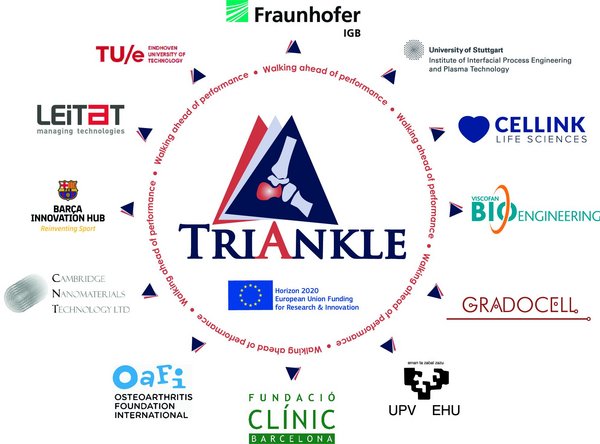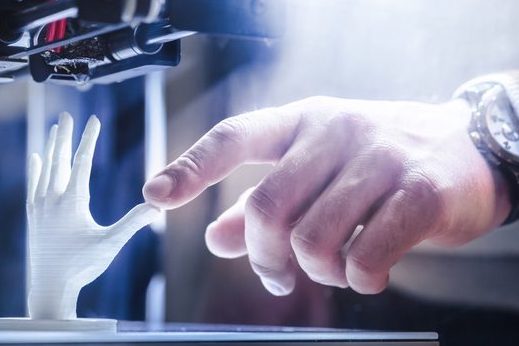Spanish football club FC Barcelona’s R&D lab, Barça Innovation Hub, has joined the EU-backed ‘TRIANKLE’ project to help test its upcoming 3D bioprinted cell-restoring ankle implants.
The twelve-strong group of companies, including bioprinting firm CELLINK, is developing collagen-based cell grafts that could reduce patient recovery times by up to 50 percent. In joining the program, Barcelona has now agreed to test the transplants on its amateur squad, with a view to optimizing their performance, and preparing them for a future commercial release.
“CELLINK is thrilled to be a part of the TRIANKLE project and contribute to unlocking the potential of innovative 3D printing technology for regenerative medical applications,” stated CELLINK. “Launching this technological platform will enable the development of future regenerative therapies for joint tissues in weight-bearing joints.”

Has project TRIANKLE got the winning formula?
The TRIANKLE project is a subset of the wider European Horizon 2020 program, an €80 billion scheme that provides additional funding to promising areas of research. Horizon’s €5.9 million TRIANKLE program, which is due to start next year, will see its members develop therapies that accelerate the recovery of ankle joint tissues.
The group’s twelve members, including scientists from Leitat Technological Center and Fraunhofer IGB, have already identified the need for alternative ankle remedies. According to the group, current therapies fail to return tissues to full functionality, meaning that those with tendon or cartilage injuries often suffer from recurrences.
Using 3D bioprinting, the group is now developing personalizable implants, that are designed to address the drawbacks of common tendon-related treatments. The consortium estimates that utilizing an enhanced hydrogel, recovery times could be reduced by up to 50 percent, and the functionality of injured tissues improved by 10-15 percent.

Barcelona’s role in the project will be to perform preclinical assessments of the implants by testing them on its amateur athletes and retired former players. As a result, Barcelona may be trialling the new hydrogel on its squad, but don’t expect superstars like Lionel Messi to be receiving additive treatments any time soon.
However, the project’s goal isn’t just to reduce the club’s injury list, but to unlock 3D bioprinting technology’s potential, and drive its wider adoption. Given that treating osteoarthritis costs €76.5 billion a year alone, the TRIANKLE consortium estimates that its hydrogel could generate significant cost savings within clinical settings.
Elsewhere in the Horizon program, Barcelona is also installing an innovative ‘IOTwins’ system at its Nou Camp stadium. Using an Internet of Things (IoT) and Artificial Intelligence (AI) software, the Spanish club will be able to analyse the way people move around the ground, and optimize the way in which this is managed.

CELLINK’s bioprinting involvement
Although it’s currently unclear which TRIANKLE member will actually produce the new hydrogel, CELLINK’s involvement is a major coup for the project. Having been allocated €622,000 of the program’s funding, the firm will at least play some role in the product’s development, bringing a wealth of bioprinting experience with it.
CELLINK is a global life-science business that has over 1,000 labs, and provides 3D bioprinting technologies, products, and services to clients in 55 countries. The firm’s current line of systems, which feature its Clean Chamber Technology, include the SLA-based Holograph X, dual-extrusion INKREDIBLE and six-printhead BIO X6.
Recently, the company signalled its intent to expand on its markets via the acquisition of 3D printing firm Scienon, and its involvement in TRIANKLE fits into this broader strategy. CELLINK’s materials range also includes several tissue engineering kits that could form a basis for TRIANKLE’s new ankle-regenerating hydrogel.
What’s more, the firm’s extensive machine portfolio and client base could provide an ideal platform on which the program can build. However, as important as CELLINK’s involvement could be, it should also be noted that bioprinting is not highly commercialized, and the technology is thought to be years away from end-usage.
Existing additive ankle-joint applications
Although ankle tissue implants remain at an experimental stage, some firms have managed to 3D print polymeric orthotics, to aid those with foot-related injuries.
3D printer manufacturer 3D Systems, recently received 510(k) clearance from the FDA for its additive manufactured Vantage Ankle PSI surgical ankle instrument. The patient specific device, which was developed alongside surgical firm Exactech, is designed to facilitate the bone-shortening direct-osteotomy procedure.
3D printing specialist Ricoh 3D has worked with medics at The Orthotic Research & Locomotor Assessment Unit to fabricate a lever-hinge mechanism for ankle-foot orthotics. The collaboration also yielded ISO 13485 certification for the firm, recognizing its quality management capabilities within the medical industry.
Students at Gonzaga University, meanwhile, have developed a new approach to producing Ankle Foot Orthosis (AFO). Using a combined 3D printing and scanning technique, the team were able to remove the trial and error from the prototyping process, and reduce the part’s associated lead times.
To stay up to date with the latest 3D printing news, don’t forget to subscribe to the 3D Printing Industry newsletter or follow us on Twitter or liking our page on Facebook.
Are you looking for a job in the additive manufacturing industry? Visit 3D Printing Jobs for a selection of roles in the industry.
Featured image shows a Barcelona B team player jockeying for possession. Photo via Barcelona B.



